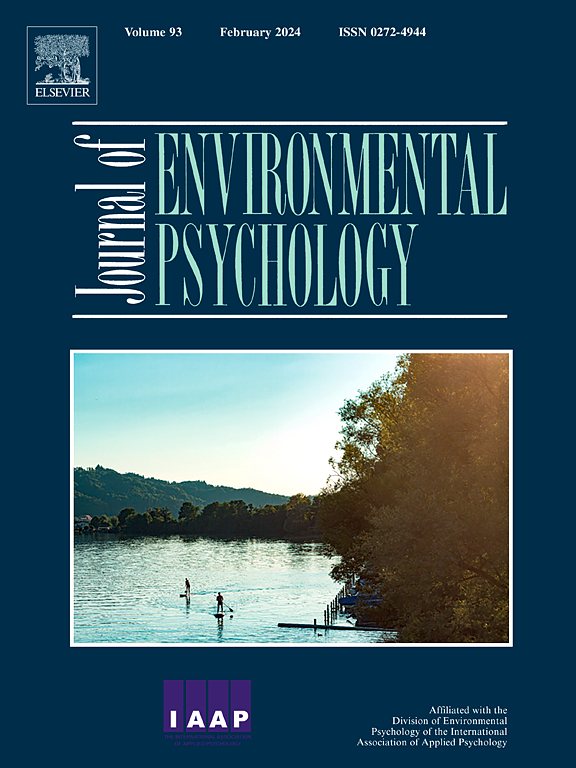The impact of built and natural environments on working memory - A systematic literature review
IF 7
1区 心理学
Q1 ENVIRONMENTAL STUDIES
引用次数: 0
Abstract
This systematic literature review examines the complex relationship between the physical environment and working memory essential for everyday life. As urbanization accelerates and the built environment becomes more complex, impacting natural environments as well, understanding how environmental factors influence working memory is becoming increasingly critical. This review synthesizes findings from 34 empirical studies investigating the effects of different environmental settings, ranging from urban environments to natural landscapes on working memory performance or development. We categorize these findings into three key themes that reflect how this relation has been studied: Dynamic Environmental Exposure, which refers to settings where individuals actively engage with their surroundings; Passive Environmental Exposure, which encompasses studies where participants remain stationary while being exposed to environmental stimuli; and Neighborhood Characteristics, which include broader aspects of our living environments that shape daily experiences and may influence working memory over extended periods. The review discusses the findings with reference to ecological validity of experimental setups, the challenge of describing physical settings, and future implications of the research, while also encouraging interdisciplinary collaboration among architects, urban planners, psychologists, and neuroscientists. This work also contributes to the growing discourse on how the design of our physical settings effects cognition, thereby health and well-being.
人造环境和自然环境对工作记忆的影响——系统的文献综述
这篇系统的文献综述探讨了物理环境和日常生活中必不可少的工作记忆之间的复杂关系。随着城市化进程的加快,建筑环境变得越来越复杂,自然环境也受到影响,了解环境因素如何影响工作记忆变得越来越重要。本文综合了34项实证研究的结果,这些研究调查了从城市环境到自然景观等不同环境对工作记忆表现或发展的影响。我们将这些发现分为三个关键主题,反映了这种关系是如何被研究的:动态环境暴露,指的是个人积极参与周围环境的环境;被动环境暴露,包括参与者在暴露于环境刺激时保持静止的研究;邻里特征,包括我们生活环境的更广泛方面,这些方面塑造了我们的日常经历,并可能在很长一段时间内影响工作记忆。这篇综述讨论了实验设置的生态有效性、描述物理设置的挑战以及研究的未来意义,同时也鼓励建筑师、城市规划师、心理学家和神经科学家之间的跨学科合作。这项工作也有助于越来越多的关于我们的物理环境的设计如何影响认知,从而影响健康和福祉的论述。
本文章由计算机程序翻译,如有差异,请以英文原文为准。
求助全文
约1分钟内获得全文
求助全文
来源期刊

Journal of Environmental Psychology
Multiple-
CiteScore
10.60
自引率
8.70%
发文量
140
审稿时长
62 days
期刊介绍:
The Journal of Environmental Psychology is the premier journal in the field, serving individuals in a wide range of disciplines who have an interest in the scientific study of the transactions and interrelationships between people and their surroundings (including built, social, natural and virtual environments, the use and abuse of nature and natural resources, and sustainability-related behavior). The journal publishes internationally contributed empirical studies and reviews of research on these topics that advance new insights. As an important forum for the field, the journal publishes some of the most influential papers in the discipline that reflect the scientific development of environmental psychology. Contributions on theoretical, methodological, and practical aspects of all human-environment interactions are welcome, along with innovative or interdisciplinary approaches that have a psychological emphasis. Research areas include: •Psychological and behavioral aspects of people and nature •Cognitive mapping, spatial cognition and wayfinding •Ecological consequences of human actions •Theories of place, place attachment, and place identity •Environmental risks and hazards: perception, behavior, and management •Perception and evaluation of buildings and natural landscapes •Effects of physical and natural settings on human cognition and health •Theories of proenvironmental behavior, norms, attitudes, and personality •Psychology of sustainability and climate change •Psychological aspects of resource management and crises •Social use of space: crowding, privacy, territoriality, personal space •Design of, and experiences related to, the physical aspects of workplaces, schools, residences, public buildings and public space
 求助内容:
求助内容: 应助结果提醒方式:
应助结果提醒方式:


